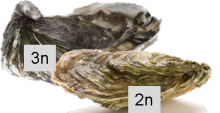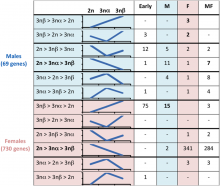
Transcriptomic profiling of gametogenesis in triploid Pacific Oysters Crassostrea gigas: towards an understanding of partial sterility associated with triploidy.
Dheilly Nolwenn M., Jouaux Aude, Boudry Pierre, Favrel Pascal, Lelong Christophe. (2014). PLoS ONE . 9(11): e112094.
Triploidy can occur in many animal species but is often lethal. In invertebrates, amphibians and fishes, triploids are viable but they are often sterile, or unfertile. In the Pacific oyster Crassostrea gigas, most triploids are nearly sterile (named “3nb”) but a low but significant proportion of them show an advanced gametogenesis (named “3na”).
Nolwenn Dheilly, with Christophe Lelong and Pascal Favrel (Team 2 -UMR BOREA), used microarrays to compare female and male gonad transcriptomes of 2n, 3nb and 3na during their gametogenesis. In comparison to 2n, they observed a difference of gene expression related to DNA repair, apoptosis, cell division. A misregulation on the cell cycle checkpoint during mitosis may be involved in the successful, but delayed development of gonad in 3na individuals. However, the sterility of 3nb individuals may be explained by a disruption of sex differentiation mechanisms. Indeed, 3nb females express male-specific genes and 3nb males express female-specific genes.
This study provides evidence that a disruption of sex differentiation and mitosis may be responsible for the impaired gametogenesis of triploid Pacific oysters.
Contact BOREA : Christophe Lelong, Pascal Favrel, Team 2


